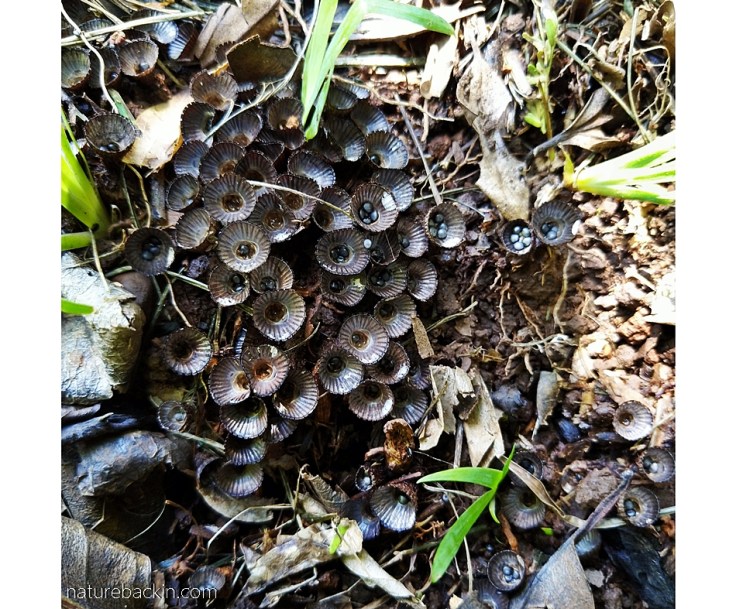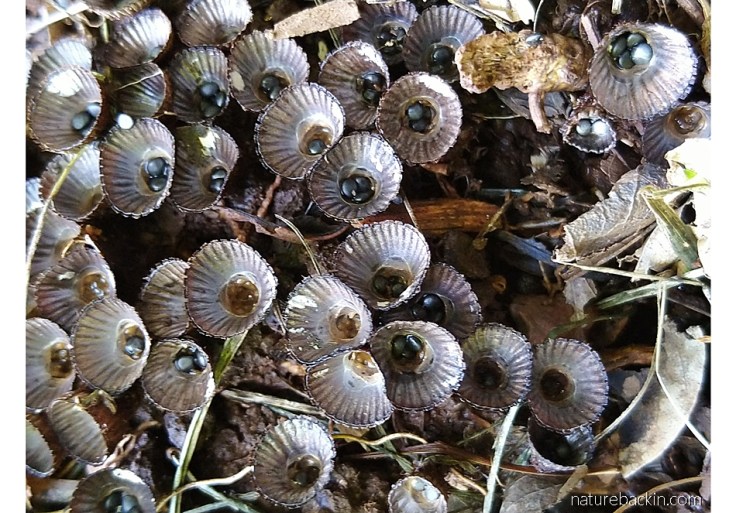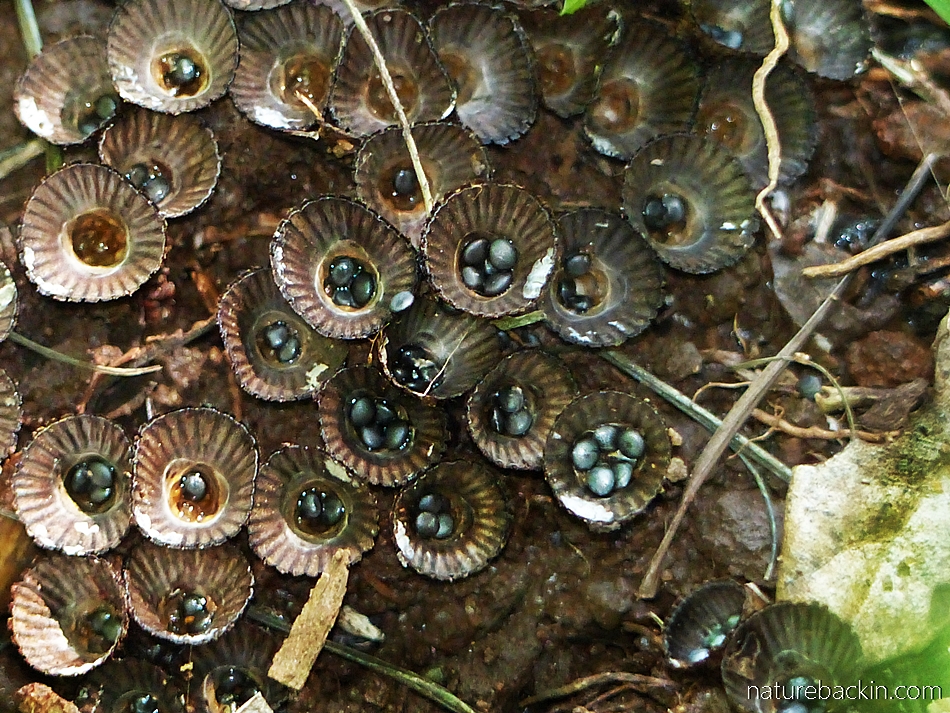No, I didn’t find fungus growing in bird’s nests, but a fungus that resembles bird’s nests. Very tiny nests to be sure, and within each nest-shaped cup nestles a cluster of egg-like capsules.

Easy to overlook, the tiny bird’s nest fungus cups are clustered together growing on soil rich in decomposing wood including sawdust
The first time I paid attention to the tiny bird’s nest fungus was only in March this year. I was watching a small pollinating fly when my eye was attracted to the shiny fluted cups that are only about 1 to 1.5 cm (around half an inch) in diameter. Down on my hands and knees I was amazed to see that within the delicately fluted cups were nested small dark capsules resembling eggs, about the size and shape of small and slightly flattened peas.

Here is a slightly closer look. Some of the cups appear to be empty, but most contain several round egg-like capsules
I realised that these little cups belonged to a fungus, and I wondered at the capsules as I had thought that fungi spread by means of microscopic spores. Once I found out that these little fungi belong to the bird’s nest fungus family I was able to learn more about their curious nest shape and the little ‘eggs’ within.

Here is a close-up the little nest-like cups, with only one containing visible egg-like capsules in its centre
Although bird’s nest fungi were first scientifically described as far back as 1601 and they attracted subsequent interest from fungus experts, it was only in the 1920s that the mechanism for how these fungi disperse their spores was first understood.
The entire fruiting body comprises the cup (peridium) that houses the round capsules (peridioles). Interestingly, the word peridiole derives from the Greek word peridion, meaning “small leather pouch”, which is descriptive of the capsule containing its cargo of spores. Each peridiole contains spores that must be dispersed in order for the fungus to reproduce.

I think the bird’s nest fungus in our garden is Cyathus striatus, the fluted bird’s nest fungus
So how do the peridioles/capsules get to release their cargo of spores? In the 1920s it was discovered that the cup-shaped “nest” is actually a splash cup. When a rain drop falls into the cup hitting the wall of cup at a suitable angle, by means of a splash mechanism the velocity of the falling drop discharges the peridiole/capsule so that it launches at speed out of the cup and flies off to a distant spot from where the spores can disperse when the peridiole/capsule ruptures.
The capsules in the Cyathus genus of bird’s nest fungi have an added mechanism, in that each capsule carries with it a funicular chord that unravels when the capsule hits an obstacle such as a plant stem and if possible the chord wraps around the obstacle so that the capsule remains elevated above the ground. When the capsule ruptures, its elevated position enables a more effective dispersal of its airborne spores.

In brighter light the striated cups of the fluted bird’s nest fungus Cyathus striatus shine with a silvery iridescence
I think that this rather wondrous diminutive bird’ nest fungus fulfills the criteria of being both odd and marvelous to qualify as a backyard curiosity. Added to its remarkable splash-dispersal discharge mechanism, the fungus itself is an efficient feeder on decaying and decomposing wood and other organic material and contributes to nutrient recycling and soil building – an asset to any garden.

To view high-speed videos of water droplets causing the ejection of capsules from the bird’s nest cup see this article by Hassett et al (2013).
Sources:
Alchetron. 2018. Cyathus. https://alchetron.com/Cyathus; Hassett, Maribeth O. et al. 2013. Splash and grab: Biomechanics of peridiole ejection and function of the funicular cord in bird’s nest fungi. Fungal Biology 117(10): 708-714. https://doi.org/10.1016/j.funbio.2013.07.008; Wikipedia. 2020. Nidulariaceae. https://en.wikipedia.org/wiki/Nidulariaceae
Posted by Carol









May 13, 2020 at 9:09 am
Just astonishing! Nature is so creative in evolving reproduction methods. This one is particularly original. The magical moment when the water droplets hits. Another marvellous gem, Carol, thank you 🙂
LikeLiked by 1 person
May 13, 2020 at 2:50 pm
Thanks Sandra. I was also entranced when I learnt about the spore dispersal by raindrop!
LikeLiked by 1 person
May 11, 2020 at 4:58 pm
Thank you for this gem, Carol! The fungus cup is one of the most beautiful and marvelous wonders that you have introduced me to. Your photographs are exquisite. The interplay of water and cup to release the tiny spores moved me. I’m not sure why the story struck such an emotional chord in me. There is something of the divine in the form and function. And perhaps I am comforted to know that this wondrous, magical, and beautiful natural process is occurring not-so-hidden in the chaos and destruction of the coronavirus. That both can exist is reason to hope. Oh how I would love to see a time-release video of the process. But your photos will stay with me. Thank you.
LikeLiked by 1 person
May 11, 2020 at 6:32 pm
Thanks Cheryl. Yes they are magical these little cups and there is something strangely and aesthetically satisfying when we recognize a precise relationship between form and function. I also find it comforting that such processes go on alongside the awful progression of the Covid-19 pandemic.
If you click on the link to the article I mention at the end of the post and scroll through it you will come to slo-mo clips of high-speed videos that capture the spore capsules discharging under the force of a falling water droplet.
LikeLiked by 1 person
May 12, 2020 at 2:17 am
Oo wonderful. I missed the reference in my first reading. Thank you. They’re like the reverse of throwing pennies in a fountain. Magical. They grow the wishes.
Thanks again for introducing me to these wonders.
LikeLiked by 1 person
May 12, 2020 at 1:50 pm
That is a lovely analogy – magical wishes.
LikeLiked by 1 person
May 10, 2020 at 8:57 am
How interesting – we have birds nest fungi in the UK but I’ve never found one. I didn’t know their range extended as far as South Africa.
LikeLiked by 1 person
May 10, 2020 at 6:20 pm
It seems that the sawdust (after sawing up a fallen tree) that we sprinkled in the flower bed is what triggered the fungi to sprout. It is surprising how cosmopolitan they are.
LikeLike
May 10, 2020 at 4:16 am
Fascinating Carol, what a lovely post! xxx
LikeLiked by 1 person
May 10, 2020 at 6:10 pm
Thanks Christeen.
LikeLiked by 1 person
May 9, 2020 at 10:24 am
Adore these. Always a delight to find. Now I know a whole lot more about them.
LikeLiked by 1 person
May 9, 2020 at 5:31 am
Utterly fascinating find, Carol! Proof again that there’s so much to marvel at in nature, even in the yards we see daily.
LikeLiked by 1 person
May 10, 2020 at 6:09 pm
That is true – one can find nature even in the most unexpected places.
LikeLiked by 1 person
May 9, 2020 at 4:43 am
Well, that’s anew one for me. Never heard of these before, but quite fascinating. Makes one wonder how something so geared to certain conditions evolved. What a wonderful garden you have.
LikeLiked by 1 person
May 8, 2020 at 9:52 am
Such intriguing fungi, Carol! I really enjoyed the pics and learning about them.
LikeLiked by 1 person
May 8, 2020 at 4:07 pm
Thanks Christine. They definitely are intriguing.
LikeLike
May 8, 2020 at 9:34 am
You and your garden are an endless source of the most fascinating information
LikeLiked by 1 person
May 8, 2020 at 4:06 pm
Thanks Mariss 😊
LikeLiked by 1 person
May 8, 2020 at 5:22 am
‘Odd and marvellous’ definitely seems to cover it. Those videos you drew our attention to were fascinating too. Hope you’re still surviving New Normal.
LikeLiked by 1 person
May 8, 2020 at 8:48 am
Glad you looked at those intriguing videos. We are surviving thanks and so far we are fortunate in our personal circumstances. However, the huge and growing number of people in the country without adequate (or even any) food, is appalling.
LikeLiked by 1 person
May 8, 2020 at 2:53 pm
I know, There are growing numbers of people in increasingly desperate circumstances
LikeLiked by 1 person
May 8, 2020 at 4:08 pm
Very sad and sobering times.
Take care and keep safe.
LikeLiked by 1 person
May 8, 2020 at 5:40 pm
You too.
LikeLiked by 1 person
May 8, 2020 at 5:44 pm
Thanks.
LikeLiked by 1 person
May 8, 2020 at 5:06 am
I have never seen such a fungus before and how fascinating they are. Well spotted! This has been an interesting and delightful read.
LikeLiked by 1 person
May 8, 2020 at 8:45 am
Thanks Anne. They are a bit fairytale-ish!
LikeLike
May 8, 2020 at 12:42 am
We have them here, too. One of the few things we similarly share!
LikeLiked by 1 person
May 8, 2020 at 8:44 am
Yes – it is interesting how cosmopolitan they are.
LikeLike